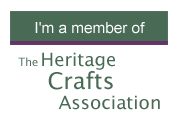Polly Bennett

POLBEN's Pigment
Polly's practice celebrates the natural environment, engaging with and using natural matter to create her work. Honouring our world, she aims to cut out all synthetic and man-made pigments from her practice, decreasing her involvement in the carbon footprint of manufacturing paints, etc.
From a young age, she has been a collector of found objects and this progressed into seeking a way to reuse, repurpose and recycle her finds in an artistic context. As a result of this, she not only looks for mineral and botanical pigments but regularly visits her 'local refuse', the Thames foreshore, to collect historical waste that creates an array of colours, this includes: bone, industrial waste, shells, plastic and rusty metal.
She mixes her own colours from pigments she has collected around the world - although with a particular interest in her locality, Britain - and slowly but surely, her pigment collection is growing. She also uses plant and organic matter to produce water-based inks, and experiments with various additives to create a range of shades from single colours.
Through POLBEN’s Pigment Polly produces artist’s pigments and inks created from organic and recycled materials sourced by herself. The products engage people with processes long forgotten, and encourage environmentally friendly practices by using natural materials found all around us. Community and a sense of place is also acknowledged as the use of pigments has provided us with the means of expression since prehistoric times, and collecting such material reconnects us with our rural environment.
The pigments can be mixed with any binder, e.g. gum arabic, linseed oil, printmaking ink, etc. to create a wide range of artist mediums and can be used to colour setting agents like plaster. The inks are ready to use with brushes, nibs or quills, and the oak gall inks can be used as stains. The possibilities are endless!






Grinding various hard and soft organic matter for the pigment:




The oldest and most common black pigments are Ash Black, Lamp Black, and Bone Black.
Ash Black: wood ash.
Lamp Black: soot collected from oil lamps.
Bone Black: cooked and ground bone. Bone pigments can range from white to grey to black, depending on if they have been oxidised or not – this can be controlled by being tightly sealed in a container. The following image shows two shades of grey produced from bones cooked together:

Mullering pigments into glaze for various decorative painting techniques.
Polly used the black Jurassic Coast, Dorset, pigment in her trompe l'oeil rocks, representing the geology of the High Tatras in Slovakia.


The black pigment was collected on the Jurassic Coast.


When making inks, Polly will reduce the plant-based material in water and add various substances to bring out the natural colour even more.
Vinegar (which contains acetic acid) is probably the most traditional source of an acidic ink, however Polly prefers to use alkaline inks (a mixture of soda ash and water) as they won’t corrode your paper over time.
Vinegar is used in inks as it helps retain the colour and prevents bacteria growing. Originally people would put a clove of garlic in their inkpots for its anti-bacterial properties, however it’s less common to use vinegar or garlic now mainly because of the smell. Instead, use a couple drops of thyme essential oil, or any essential oil that is antibacterial!
A mordant is a substance, typically an inorganic oxide, that combines with a dye or stain to fix it to a material.
Alum is one of the most commonly used mordants, and is considered quite ecological, as it is used to purify water: scientists are injecting it into lakes to neutralize the pollutants that fuel algae blooms.
Soda ash (also known as washing soda or sodium carbonate) is an alkaline mordant that brings out different colours from plant material. It is also a fixative for dyes, and is a naturally occurring chemical, found in soil and water.
Iron, acting as a modifier, is used to darken the colour of an ink or dye but is also used as a mordant. Iron is famously used when making Oak Gall ink.
Polly also uses Gum Arabic, a binder that increases the inks viscosity and binds it with the paper.




A collection of Polly's pigments and homemade inks and watercolours:



